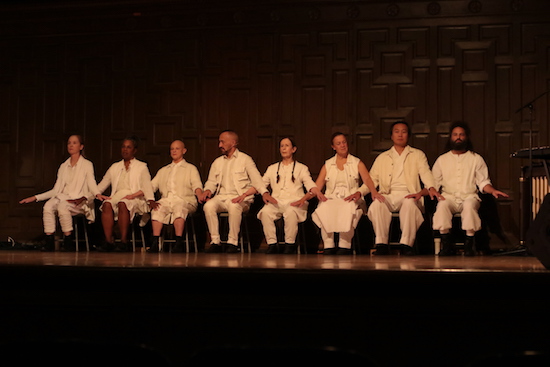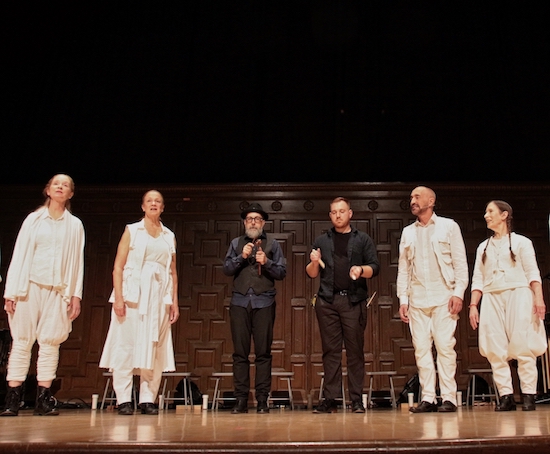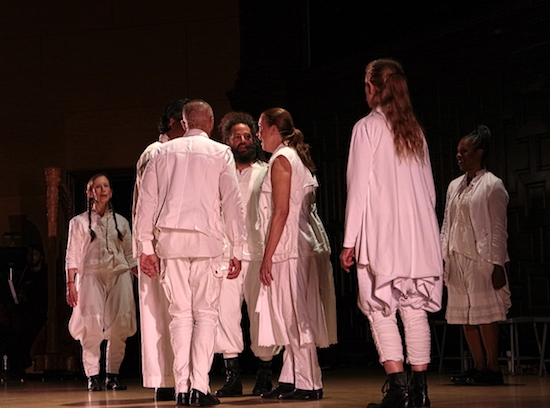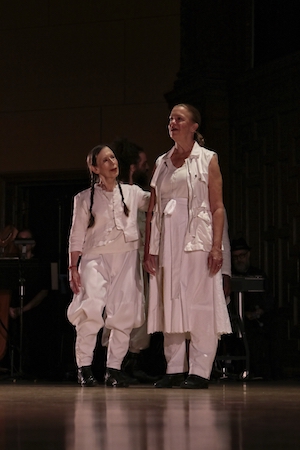
What is Indra’s Net? To begin with, it’s the name of Meredith Monk’s newest work. Yes, but what is it? In Buddhism, it alludes to the interconnectedness of everything in the universe and beyond. The world is a web with a pearl tied in its every knot, and each pearl reflects everything that exists. I pursue the inspiring concept as carefully as I can.
I did not see Indra’s Net sitting amid the crowd watching it in the Jeannik Méquet Littlefield Concert Hall at Mills College in Oakland, California, although I could hear the cheers when the premiere of this concert version ended. And now, seated in front of my laptop, gazing at its small screen, I endeavor to understand the often inch-high figures that sing and dance and gesture so eloquently within in its frame. To credit Joe Levasseur’s lighting and Yoshio Yabara’s white costumes, I have to squint at the photos of credits that I snapped on my i-phone. (That’s also how I learned that Allison Sniffin not only performed, but worked on preparing the score and, with Monk, on its orchestration).
Having watched Monk’s work since the mid-1960s, her many vibrant small pieces live in my memory. But I also recollect her large-scale ventures, such as the three-installment Juice (1969), Needle Brain Lloyd and the Systems Kid (1970), and Vessel (1971). They weren’t dances, although her performers danced, and they weren’t operas, although her performers sang. Juice was billed as a “Theater Cantata;” Needle Brain Lloyd was termed a “Live Movie;” Vessel was an “Opera Epic.”
Monk, who came from a musical family, eschews words in Indra’s Net most of the time. She and her colleagues sing syllables, treating these as conversations that all of them understand. Unlike opera singers, who may position themselves front and center to deliver arias, they look at one another—nod, smile, gesture. The instrumentalists of Indra’s Net are grouped on both sides of the theater’s stage—wider at the front than at the back. There’s no conductor. They too seem to confer.
The eight singer-dancers enter, wearing differently cut white costumes and black boots. They step in unison. Although the woodwinds may on occasion tangle harshly, the work that Monk has created is spare and delicate. You notice the careful details, such as the way the performers place their hands once they are seated on a row of chairs. You’re always aware of how aware they are of one another, and how intently Monk herself watches them.
We’re intent too. When the people walk into a group of five and one of three, we may notice how they slightly, occasionally, and individually bend the knee of the foot they’re stepping onto. When four meet in the middle of the space and seem to chat, you can imagine for a second or two a square dance. Everything they do seems pure. They form a circle and step sideways, making the shape travel to the right. A slight change elicits counterpoint. In silence, they look at one another, then pair up to walk, one person’s hand on his/her partner’s back.

Everyone walks to the back and sits on the chairs placed in a row there. The scene darkens. Like us, the singer-dancers listen to the instrumentalists. It seems important that five of them stand, then gradually others, until all are erect. Then one low note is heard. Silence. Thirty-eight minutes have elapsed since Indra’s Net began. Monk addresses the audience, sharing more about what they’ve just seen of the three-part piece.
Everyone onstage is part of a community. Paul An places his hand over his heart when he sings to Katie Geissinger. His words are “ha” and “ah.” She replies in the same way. Three people turn to watch Allison Sniffin as she stands simply, singing without instrumental accompaniment. When Theo Bleckmann begins to sway, to turn a bit, the three focus on him. When the four of them gradually come close together, they really look at one another and then turn to face the stage left instrumentalists, doubling each of their vocal parts. Then they all stop.
There are mysteries in this neighborhood—ones not meant to be solved. When tenor Gideon Crevoshay begins to sing quietly, his fingers seem to pour something; he looks at his hands. What are he and Monk thinking when they stare at An, who smiles and walks into darkness? Often it seems (how?) that everyone onstage is waiting for. . .what? That everyone has questions. Are the three men plotting something when they walk, bending their knees to coincide with the movements of their vocal lines? What makes the dancers-singers-actors kneel and then curl up on the floor in very dim light? When silence falls, and everyone is still, they awake, sit, slowly rise, and walk toward the exits, then turn to contemplate the space they have occupied. An hour and almost nine minutes have gone by. But how much virtual time has passed?

In the end, something quite simple becomes compelling. The singers walk forward, each stopping at certain point. Slowly, slowly they come into unison, bent over, turning, leaning, singing different melodies. They turn to face the instrumentalists who are now all playing. Then the lights dim. Then comes the standing ovation.
Indra’s Net. The interconnectedness—the mingling— of everything. And what lies beyond it.


Just to let you know that I’m still alive and continue to read and enjoy your reviews and other writings. . I remember well the first time I saw Meredith Monk . I had just landed on a flight from Tel Aviv, hardly able to keep my eyes open, but went directly from the airport to a Merce Cunningham performance.l. . The company was excellent but what really kept my eyes open was Meredith Monk’s contribution. Wow ! I have enjoyed her many times since then.
Thank you, once again, for your writings. which always make me feel as though I’ve seen the Performance with you..
I send my best wishes,
Richard Gibson
.